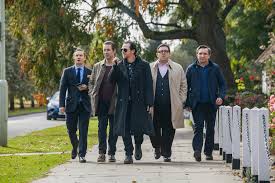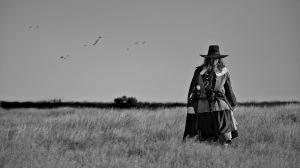
NOTE: I wrote the following article around September 2011 prior to the release of Steven Spieberg’s Tintin film (which turned out to be very good), but didn’t publish it anywhere. I’m adding it here, for anyone who is a fan of the comics, or for anyone who is unfamiliar with Tintin and would like to know more.
To celebrate the long awaited upcoming release of Steven Spielberg’s take on Tintin, here’s a rundown on his adventures and an explanation for the uninitiated as to why they are quite simply the greatest comic books ever.
Overview:
The Adventures of Tintin comprise twenty four comic book albums featuring intrepid young reporter Tintin, his faithful fox terrier dog Snowy, and later equally iconic characters such as Captain Haddock, the incompetent Thompson twin detectives, the highly intelligent but deaf Professor Calculus and opera singer Bianca Castafiore. The stories are a series of superbly crafted adventures, meticulously researched and beautifully drawn in a completely unique visual style that has captivated children of all ages across several nations.
The initial Tintin stories appeared in Le Petit Vingtieme, a children’s supplement for Belgian newspaper Le XXe Siecle. Creator Georges Remi (who wrote under the pseudonym Herge) initially devised them as a form of anti-communist propaganda. Indeed, the first adventure, Tintin in the Land of the Soviets, is little more than that. It is also the only time the eponymous young reporter actually files any kind of actual newspaper report, despite the fact that journalism is his stated profession throughout all twenty three subsequent stories. Tintin was an instant hit, and as the popularity of the comics grew, both the overt anti-communist stance and the subsequent casually racist French colonial attitudes of the second album Tintin in the Congo were dropped in favour of straightforward adventure storytelling. Later Herge spoke of both of these initial stories as “the sins of his youth”.
With The Blue Lotus Herge created his first Tintin masterpiece; a riveting tale of espionage and drug smuggling set against the Japanese invasion of China. Subsequent Tintin adventures, including classics like The Black Island and King Ottokar’s Sceptre, were also critically acclaimed, although the advent of the Second World War and its aftermath brought more controversy for Herge. He was allowed to continue publishing by the Nazis, but was accused of collaboration after the war. Herge protested, insisting he was simply doing a job like a plumber or carpenter, and all charges were dropped. Nevertheless, it is particularly interesting to study the stories he wrote during the war. The Shooting Star in particular has a somewhat apocalyptic tone with its tale of a meteor hitting the Earth. In the subsequent race across the ocean to find the meteor and lay claim to the new elements it contains, the villains in the original version are stereotypically Jewish Americans. In later versions of this album, the nationality of the rival expedition was changed to that of a fictional country.
It was around this time that the greatest figure in the Tintin stories was introduced: Captain Haddock. By far the most interesting and fully-fleshed out character in the series, Haddock stands out in stark contrast to Tintin. Whereas Tintin seems an ageless, almost sexless everyman character with no family background that is ever explained, Haddock has a fascinating character arc that lasts throughout several stories. Herge takes him from drunken, washed-up freighter captain (in The Crab with the Golden Claws, where he is unaware that his own vessel is being used to smuggle drugs), to someone with a mysterious and fascinating ancestry (The Secret of the Unicorn), after which he ultimately comes into his inheritance as the master of the magnificent Marlinspike Hall. In spite of this, his penchant for whisky is never really cured, and is played – with politically incorrect glee – for laughs throughout most of the remaining stories, along with him being incredibly accident prone and bad tempered.
The Secret of the Unicorn and its sequel Red Rackham’s Treasure are considered amongst the very best in the Tintin canon, along with the subsequent two album story The Seven Crystal Balls and Prisoners of the Sun. The latter epic is a truly riveting adventure that rivals any Indiana Jones film for sheer thrills; not to mention a few more scares than usual, especially in the first part. It came as no surprise to me to learn that if the Spielberg Tintin film (based on elements of The Crab with the Golden Claws and The Secret of the Unicorn) is a success, then Peter Jackson will direct a version of The Seven Crystal Balls/Prisoners of the Sun duo. His horror movie background makes him an ideal choice for the voodoo plot. Here I might as well add that between them these two – The Seven Crystal Balls and Prisoners of the Sun – constitute my favourite Tintin story of all time.
After this came further classics, including Destination Moon and Explorers on the Moon (written before the moon landings of 1969), and The Calculus Affair, another personal favourite of mine involving an arms race for sonic weapons. Herge later experienced a nervous breakdown, and in the aftermath produced Tintin in Tibet, perhaps the most emotional Tintin story. It features no villains, and the plot contains a number of direct visual references to what he experienced. For instance, much of the action is set in the snow covered Himalayas, and Herge described his nightmares at the time as “all white”.
The Castafiore Emerald was a fascinating narrative experiment, in that Herge desired to tell a suspenseful story in which nothing actually happens. For me, The Castafiore Emerald is easily one of the absolute best Tintins, though its sophisticated humour is more aimed at adults than children. This was followed by the intriguing Flight 714, which involved a hijacking and later UFOs. The final complete Tintin album, Tintin and the Picaros, was a disappointment. There was also a final unfinished Tintin story, Tintin and Alph-Art, published after Herge’s death in 1983.
Interestingly, Herge always saw his comics as movies, and was thrilled when Spielberg bought the rights in 1981. Thirty years later, the question as to whether Spielberg can do Herge’s iconic creation justice is about to be answered, but the comics remain. I commend them for discovery (or rediscovery, for those who haven’t had deprived childhoods).
Book by book:
Tintin in the Land of the Soviets – The first Tintin adventure sees him visiting communist Russia to report on the situation there. The plot is little more than a series of propaganda vignettes, and features little of the superbly judged mixture of thrills and slapstick comedy so prevalent in later Tintin albums. For completists only. Rating: 3/10.
Tintin in the Congo – The controversial one that remained un-translated for decades. Tintin’s adventures in the Congo are a largely crass affair, with racist stereotypes galore and a rambling plot that lurches all over the place. Again, for completists only. Rating: 2/10.
Tintin in America – Tintin goes to Chicago to take on Al Capone and other gangsters. Packed with thrills and spills, it’s a fast paced affair that doesn’t quite scale the heights of later adventures, but still worth a look. Rating: 6/10.
Cigars of the Pharoah – Tintin takes on a particularly nasty drug smuggling organisation, and globe trotting thrills ensue. Features the first appearance of recurring villain Rastapopoulus, although because the story was extensively redrawn by Herge, an apparent continuity error is introduced when Tintin refers to it not being the first time they have met. Rating: 8/10.
The Blue Lotus – Following on from Cigars of the Pharoah (an afterthought as Herge redrew the beginning pages), Tintin goes to Shanghai to investigate espionage and drug smuggling at the time of the Japanese invasion. The Blue Lotus also incorporates elements of the Mukden railway bombing incident, and other genuine historical events into its superb plot. Probably the best of the non Captain Haddock Tintin stories. It is also one of the few Tintin stories (along with The Broken Ear and Explorers on the Moon) where the main villain ends up dead as opposed to in police custody. Rating: 10/10.
The Broken Ear – A museum break in leads to a hunt for a stolen South American fetish in this cracking adventure. Recurring character General Alcazar is also introduced, and there are other characters (the explorer Ridgewell and Pablo), who later return in Tintin and the Picaros. A personal favourite, and in my view somewhat underrated by Tintin fans. Rating: 9/10.
The Black Island – Another classic that was also extensively redrawn, this adventure sees Tintin take on a gang of counterfeiters based on a sinister island near the west coast of Scotland. It is interesting to note that Herge did very little actual travel, but relied on research photographs of real places for many of the cells that appear in the comics. As such, The Black Island is full of “real places”. Rating: 10/10.
King Ottokar’s Sceptre – The first of a few Tintin stories to be set in the fictional Balkan countries of Syldavia and Borduria. Tintin attempts to rescue King Ottokar from a particularly unorthodox coup, in which the King is forced to abdicate if he doesn’t appear in public with his sceptre on a certain day of the year. When the sceptre is stolen, Tintin has a fiendishly difficult puzzle to solve. Absolutely cracking. Rating 10/10.
The Crab with the Golden Claws – The story that introduces Captain Haddock is not only a first rate thriller, but it sets up the relationship between Tintin and Haddock for the adventures that followed. It’s worth noting that Haddock is a particularly edgy character here, and unlike subsequent stories his drunkenness is not played for laughs. At several points in the story he attacks Tintin either as a result of drinking or – in one sequence in the Sahara – because he hallucinates that Tintin is a bottle of booze. Such moments were watered down in the otherwise largely faithful early 90s cartoon series, and will no doubt also be absent from the upcoming Spielberg film. Rating: 10/10.
The Shooting Star – A meteor hits the Earth, and two rival expeditions race across the seas to lay claim to the valuable new minerals it contains. Controversial because it was produced under Nazi occupation and contains villains that arguably resemble anti-Semitic caricatures, this is nevertheless an exciting albeit hugely implausible adventure which ultimately includes sci-fi elements like giant insects. Captain Haddock also makes a welcome return and this time really takes charge (despite his continued love of whisky). Rating: 9/10.
The Secret of the Unicorn – When Tintin happens upon mysterious clues to buried treasure hidden in a model ship, a link with Captain Haddock’s naval ancestry emerges. Regarded as one of the absolute best in the series and I agree. Rating: 10/10.
Red Rackham’s Treasure – The sequel to The Secret of the Unicorn works very well, but I don’t think it’s quite as good as its reputation suggests for a couple of reasons. Firstly, the villain Max Bird fails to make a return, despite the fact that he escapes from prison. Secondly, there’s a sense of much ado about nothing, in that the ocean voyage and diving expeditions are ultimately rather pointless. That said this is the story that introduces Cuthbert Calculus, and the way he goes from an irritating man who simply won’t take no for an answer to trusted friend is very nicely handled. Captain Haddock also comes into his own here, as he gains his inheritance – both his ancestral home Marlinspike Hall and the treasure obtained by his ancestor. Rating: 9/10.
The Seven Crystal Balls – A curse of the Inca type plot ensues after seven archaeologists fall into a seemingly irreversible coma only to awaken at the same point every day screaming in apparent agony. Known as the “slightly scary” one by Tintin fans, it is also a prelude to Prisoners of the Sun, when Professor Calculus is kidnapped by members of an ancient Inca cult. Rating: 10/10.
Prisoners of the Sun – Tintin and Captain Haddock journey to South America to try and find Calculus. When they discover he is to be sacrificed the Inca sun god, they undertake an epic quest to rescue him across mountains and jungles and through secret tunnels to the hidden temple of the sun. Predating Indiana Jones by several decades, this is thematically similar and an absolutely stunning adventure story. Rating: 10/10.
Land of Black Gold – A slightly all over the place adventure involving petroleum sabotage, this only features Captain Haddock briefly. His appearance feels very tacked on, no doubt because this was a comic that was started before the war, abandoned, then redrawn after the war once Haddock had become a regular character. The villain from The Black Island makes a return too, and Emir Ben Kalish Ezab and his spoiled brat child Abdullah also are introduced. Rating: 6/10.
Destination Moon – The two part moon race adventure is more of an espionage tale in the first part, although certain mysteries are not answered until the latter installment. Fascinating in that it was written before the moon landings, yet is as brilliantly researched as ever. Possibly too well researched, as there is a fair bit of scientific detail that bogs things down a bit. Rating: 9/10.
Explorers on the Moon – Part two of the moon race story sees Tintin and our heroes actually fly to the moon in a rocket, to mostly satisfying effect. Rating: 9/10.
The Calculus Affair – A personal favourite, this one sees Calculus kidnapped again. Rival faux Balkan countries Syldavia and Borduria want his research into soundwaves to build their own sonic weapons of mass destruction. Inspired by Nazi war experiments, this is a first rate thriller marred only by the somewhat irritating introduction of recurring character insurance salesman Jolyon Wagg. Rating: 9/10.
The Red Sea Sharks – The Emir and Abdullah return in this entertaining if somewhat flawed tale of arms dealing and modern slave traders. Much stronger in the second half, particularly when Tintin and our heroes are under siege from a submarine. There were some accusations of racism in the portrayal of Africans as very simple people, but Herge’s moral disgust at slavery is worth applauding nevertheless. Rating: 7/10.
Tintin in Tibet – Prompted by a dream, Tintin goes to search in Himalayan mountains for his friend Chang (from The Blue Lotus), who was previously believed to be dead in a plane crash. Supposedly inspired by Herge’s nervous breakdown, this is a more cerebral and emotional survival story without villains. Even the Yeti Tintin encounters Herge refuses to make an outright monster of. Rating: 9/10.
The Castafiore Emerald – This wasn’t a favourite of mine as a child, but now I would place it in my top three Tintin albums. Packed with red herrings, satirical references and comedy of errors humour regarding a gossip magazine’s mistaken belief that Haddock and Castafiore are romantically involved, this also breaks with the globe trotting tradition by being set entirely in Marlinspike Hall. Furthermore, it again develops Captain Haddock as a character as we see him magnanimously allowing gypsies to camp on the grounds of Marlinspike, against the advice of more prejudiced characters. Of course, the gypsies come under inevitable suspicion once Bianca Castafiore’s prized emerald is apparently stolen. Rating: 10/10.
Flight 714 – Tintin and friends find themselves hijacked and flown to a desert island at the behest of arch villain Rastapopoulus, only for UFOs to complicate things. Atmospheric and thrilling, though perhaps not entirely satisfying in the finale. Rating: 8/10.
Tintin and the Picaros – Tintin and friends make a disappointing return to territory previously explored in The Broken Ear. The military coup conspiracy plot is overshadowed by too many silly jokes and pointless returning characters. Rating: 4/10.
Tintin and Alph-Art – A very odd story which ends with Tintin about to be killed in Perspex and be presented as a work of modern art because Herge died before he could finish it. Interesting, but for completists only. Rating: 4/10.
And…just to be extra nerdy, here they are in my personal order of preference:
- The Seven Crystal Balls/Prisoners of the Sun (both 10/10)
- The Secret of the Unicorn (10/10)
- The Castafiore Emerald (10/10)
- The Crab with the Golden Claws (10/10)
- The Blue Lotus (10/10)
- King Ottokar’s Sceptre (10/10)
- The Black Island (10/10)
- The Calculus Affair (9/10)
- The Broken Ear (9/10)
- Red Rackham’s Treasure (9/10)
- Tintin in Tibet (9/10)
- The Shooting Star (9/10)
- Destination Moon/Explorers on the Moon (both 9/10)
- Cigars of the Pharoah (8/10)
- Flight 714 (8/10)
- The Red Sea Sharks (7/10)
- Tintin in America (6/10)
- Land of Black Gold (6/10)
- Tintin and the Picaros (4/10)
- Tintin and Alph-Art (4/10)
- Tintin in the Land of the Soviets (3/10)
- Tintin in the Congo (2/10)
Those of you who already know and love the Tintin books, no doubt you’ll be dusting them down to re-read them prior to the film. Those who haven’t read a Tintin book in their lives, I strongly recommend at least checking out the top three in the above list to give you an idea of what to expect. Enjoy!










